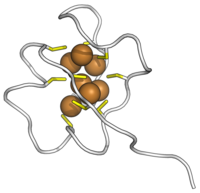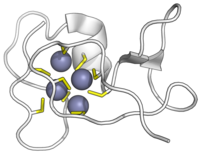 Saccharomyces cerevisiae MT metallothionein bound to copper ions. Cysteines in yellow, copper in brown. (PDB: 1AQS)
Saccharomyces cerevisiae MT metallothionein bound to copper ions. Cysteines in yellow, copper in brown. (PDB: 1AQS) Cyanobacterial SmtA metallothionein bound to zinc ions. Cysteines in yellow, zinc in purple. (PDB: 1JJD)
Cyanobacterial SmtA metallothionein bound to zinc ions. Cysteines in yellow, zinc in purple. (PDB: 1JJD)
Metal-binding proteins are proteins or protein domains that chelate a metal ion.
Binding of metal ions via chelation is usually achieved via histidines or cysteines. In some cases this is a necessary part of their folding and maintenance of a tertiary structure. Alternatively, a metal-binding protein may maintain its structure without the metal (apo form) and bind it as a ligand (e.g. as part of metal homeostasis). In other cases a coordinated metal cofactor is used in the active site of an enzyme to assist catalysis.
Histidine-rich metal-binding proteins
Poly-histidine tags (of six or more consecutive His residues) are utilized for protein purification by binding to columns with nickel or cobalt, with micromolar affinity. Natural poly-histidine peptides, found in the venom of the viper Atheris squamigera have been shown to bind Zn(2+), Ni(2+) and Cu(2+) and affect the function of venom metalloproteases. Furthermore, histidine-rich low-complexity regions are found in metal-binding and especially nickel-cobalt binding proteins. These histidine-rich low complexity regions have an average length of 36 residues, of which 53% histidine, 23% aspartate, 9% glutamate. Intriguingly, structured domains with metal binding properties also have very similar frequencies of these amino acids that are involved in the coordination of the metal. Accordingly, it has been hypothesized that these metal-binding structured domains could have originated and evolved/optimized from metal-binding low-complexity protein regions of similar amino acid content.
References
- Berg, J. M. (1990-04-25). "Zinc fingers and other metal-binding domains. Elements for interactions between macromolecules". The Journal of Biological Chemistry. 265 (12): 6513–6516. doi:10.1016/S0021-9258(19)39172-0. ISSN 0021-9258. PMID 2108957.
- Bornhorst, J. A.; Falke, J. J. (2000). "Purification of proteins using polyhistidine affinity tags". Applications of Chimeric Genes and Hybrid Proteins Part A: Gene Expression and Protein Purification. Methods in Enzymology. Vol. 326. pp. 245–254. doi:10.1016/s0076-6879(00)26058-8. ISBN 978-0-12-182227-9. ISSN 0076-6879. PMC 2909483. PMID 11036646.
- Watly, Joanna; Simonovsky, Eyal; Barbosa, Nuno; Spodzieja, Marta; Wieczorek, Robert; Rodziewicz-Motowidlo, Sylwia; Miller, Yifat; Kozlowski, Henryk (2015-08-17). "African Viper Poly-His Tag Peptide Fragment Efficiently Binds Metal Ions and Is Folded into an α-Helical Structure". Inorganic Chemistry. 54 (16): 7692–7702. doi:10.1021/acs.inorgchem.5b01029. ISSN 1520-510X. PMID 26214303.
- ^ Ntountoumi, Chrysa; Vlastaridis, Panayotis; Mossialos, Dimitris; Stathopoulos, Constantinos; Iliopoulos, Ioannis; Promponas, Vasilios; Oliver, Stephen G; Amoutzias, Grigoris D (2019-11-04). "Low complexity regions in the proteins of prokaryotes perform important functional roles and are highly conserved". Nucleic Acids Research. 47 (19): 9998–10009. doi:10.1093/nar/gkz730. ISSN 0305-1048. PMC 6821194. PMID 31504783.
- Dokmanić, Ivan; Sikić, Mile; Tomić, Sanja (March 2008). "Metals in proteins: correlation between the metal-ion type, coordination number and the amino-acid residues involved in the coordination". Acta Crystallographica. Section D, Biological Crystallography. 64 (Pt 3): 257–263. doi:10.1107/S090744490706595X. ISSN 0907-4449. PMID 18323620.